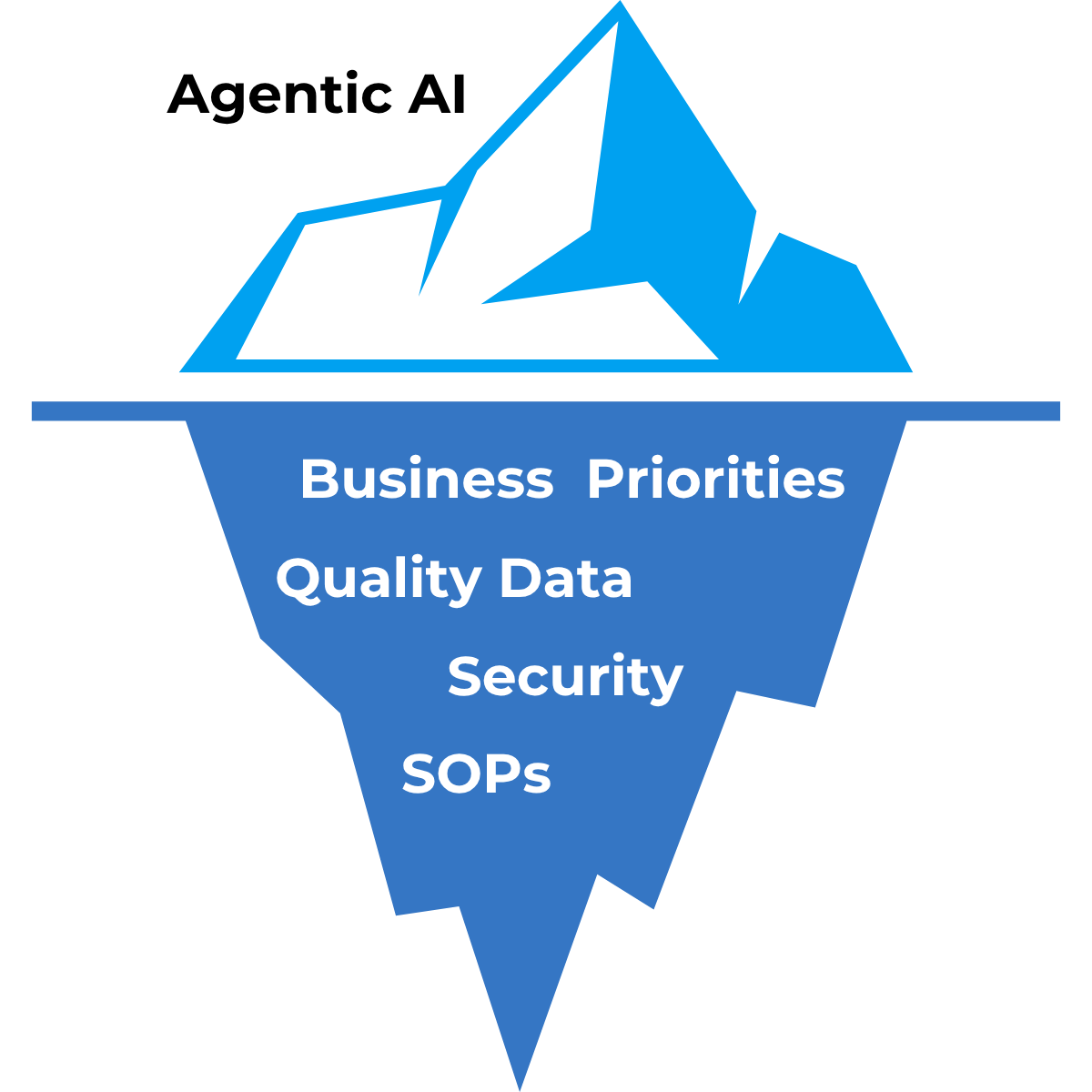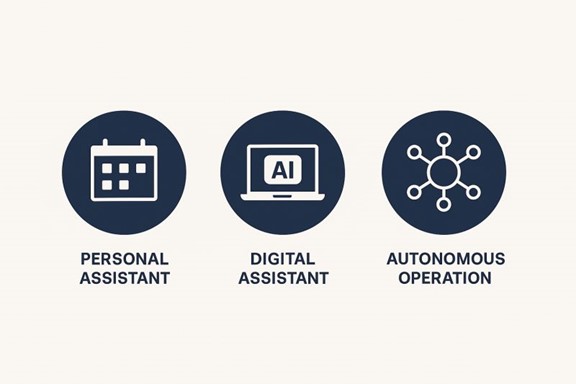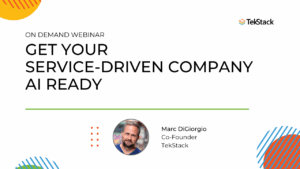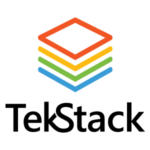
AI is transforming the business landscape, but most organizations will struggle to realize its full potential.
For service-driven companies, the promise of AI – greater productivity, cost savings, and better customer outcomes – is real, but so are the challenges.
The biggest barrier? Data quality and information architecture. Despite the hype, up to 95% of AI projects fail to deliver lasting value. The main reasons include:
- Poor data quality and bias: Most organizations lack confidence in their data.
- App proliferation: Too many disconnected apps lead to fragmented processes and inaccessible information.
- Lack of clear use cases: AI is often deployed without a strategic focus and built on use cases that do not have clear SOPs to begin with.
This article outlines a pragmatic, step-by-step approach to AI adoption, explains key AI concepts, and shows why Microsoft and TekStack are the right partners for your journey.
What’s Beneath the Surface of AI Success?
You might have seen headlines about agentic AI, those smart systems that can make decisions and take action on their own. Sounds impressive, right? But here’s the thing: the real work happens behind the scenes.
Like an iceberg, the visible benefits of AI, automation, productivity, and improved customer outcomes, are just the tip.
Beneath the surface are the foundational elements that determine whether your AI initiatives will deliver lasting value:
- Business Priorities: AI must be aligned with your organization’s strategic goals.
- Quality Data: Reliable, accessible data is the lifeblood of effective AI.
- Security: Protecting sensitive information and ensuring compliance is essential.
- Standard Operating Procedures (SOPs): Well-defined processes are needed for AI to operate autonomously.
By focusing on these hidden layers, you’ll be better prepared to unlock real business value from AI, now and in the future.
The Pragmatist’s 4-Step Approach to AI Adoption
| Step | What to Do | Why It Matters | Example Actions |
| 1. Fix Your Data | Centralize and clean up your information architecture. | AI is only as good as the data it can access. | Move files to cloud storage, auto-capture emails and meeting recaps, set up security groups. |
| 2. Pick the Right Use Cases | Align AI projects with strategic business goals. | Focus ensures ROI and organizational buy-in. | Identify high-volume, repetitive tasks; prioritize by business impact and data readiness. |
| 3. Choose the Right Level of AI Automation | Select platforms that are secure, integrated, and user-friendly. | Reduces risk and accelerates adoption. | Leverage Microsoft 365, Copilot, Power Platform, and Azure AI. |
| 4. Partner for Success | Work with experts who understand your industry and technology. | Accelerates time-to-value and avoids common pitfalls. | Engage TekStack for architecture, best practices, and implementation. |
1. Fix Your Data
80% of enterprise knowledge sits in emails, meeting recaps, and documents, often inaccessible to AI agents.
Embrace cloud storage
Ensure all business-critical documents are in secure, searchable cloud repositories. To this day, there are many companies using mapped drives and employees saving files to their local drives.
Capture communications
Automatically log customer-facing emails, calls, and meeting transcripts (with privacy controls). Without capturing this information in a central store, the insights within are not available to your agents to learn or trigger action.
Set up security groups
- Protect sensitive data and ensure only the right people (and AI agents) have access.
Integrate your systems
- Make sure there is integration across your systems of record (ex. CRM, PSA, Billing and support systems). So often, information from one system can’t be linked to another.
2. Pick Your Best Use Cases
| Strategic Priority | Increase resource utilization |
| High Volume tasks | Entering time on projects |
| AI Feasibility | Good |
| Impact | 5 extra hours each month found will result in $600,000 in annual billings. |
Start with strategy: Review your business plan and identify where AI can remove barriers or accelerate outcomes.
Look for high-volume, repetitive tasks: These are ideal for automation.
Assess feasibility: Do you have the historical data? Is the process well-defined? Can AI integrate with your systems?
Prioritize by impact: Focus on use cases that drive cost reduction, revenue growth, or improved customer experience.
3. Choose the Right Level of AI Automation
Using AI doesn’t necessarily mean jumping right into Agents with Autonomous Operations.
We’ve all been using some level of AI with Personal Assistance tasks common with generative AI tools like ChatGPT. But that’s just the first step of AI automation, the next level is Digital Assistance. We are seeing this with Microsoft embedding Copilots directly in tools we use every day, like Outlook, Teams, Excel, Word as well as their business applications. You can also use Copilot Studio to build your own assistants that connect to other knowledge sources.
But the ultimate level of AI adoption is Autonomous Operation where Agents can act autonomously triggered by external events. This requires a high level of business process definition, agent orchestration and data trust. Think of it this way, if you can’t explain to a new employee how to do a job, then you will have a tough time building an autonomous agent.
4. Why Microsoft Is the Best Option for Your AI Strategy
Security, Privacy, Compliance
Microsoft is the most trusted technology vendor for organizations, with robust controls to keep your data safe and private. Microsoft remains the last trusted vendor.
Integration
Microsoft Power Automate and the Power Platform connect your apps and orchestrate AI-driven workflows. Power Automate has 100s of predefined integrations with external tools, and an open API that can connect to any service oriented architecture.
Productivity
Microsoft 365 is already where your teams work: AI features are seamlessly integrated, reducing friction and accelerating adoption. Agents can become an extension of a Teams conversation, or embedded directly into Outlook.
Understanding Key Microsoft AI Technologies
|
Term |
Executive Definition |
|
Copilots |
AI assistants built into Microsoft 365 apps, helping users automate tasks and generate insights. |
|
Conversational Agents |
AI systems (like chatbots) that interact with users via text or voice to answer questions or automate workflows. |
|
Autonomous Agents |
Advanced AI that can make decisions and take actions independently to achieve business goals. |
|
Model Context Protocol |
Frameworks that allow AI models to securely access and use organizational data in context. |
|
APIs |
Software connectors that let different apps and AI systems communicate and share data. |
|
Teams |
Microsoft’s collaboration platform, now enhanced with AI features for productivity and knowledge sharing. |
|
Copilot 365 |
The suite of AI tools embedded in Microsoft 365, offering features like message recaps and document generation. |
|
Copilot Studio |
Platform for building and customizing AI copilots and conversational agents. |
|
Microsoft Azure AI Foundry |
Cloud-based tools for building, training, and deploying AI models at scale. |
|
Windows Entra |
Microsoft’s identity and access management solution for secure authentication. |
|
Power Apps |
Low-code platform for building custom business apps that leverage AI. |
|
Power BI |
Business analytics tool for visualizing data and generating AI-powered insights. |
How TekStack Can Help
TekStack is the fastest path to platform modernization for your service-driven business. That’s a mouthful.
Let’s put it another way, if you are a company that provides B2B services to its customers, think professional services firm, technology company, or business process outsourcer as examples, TekStack will:
- Migrate your existing information to make it AI ready
- Move you from bloated, costly, department specific business applications onto the most modern, integrated, AI-enabled Microsoft platform
- Most probably save you money each year in licensing and support fees in the process, all while
- Provide expert guidance on adopting best practices, and
- Setting your company up for roadmap towards Autonomous Operations where AI will augment existing roles creating a 10x effect on your business.
Common Pitfalls to Avoid
Neglecting change management and employee training. The opportunity for AI Augmentation is huge, but it doesn’t replace change management or relieve the need for employee training.
Underestimating the effort required to clean and organize data. Most companies have years of information debt. There is no better time to start that clean up, it will need to be done.
Over-customizing AI solutions before proving value with quick wins. Most AI project are failing, with good reason, it is possible to get some quick wins. Start slow and be focused.
What’s next?
Most organizations want the benefits of AI such as productivity, cost savings, and better customer experiences but struggle with poor data, fragmented systems, and unclear use cases. The practical approach is to centralize and clean up your information, pick use cases that align with your business goals, and choose automation tools that fit how your teams work.
TekStack and Microsoft help service-driven companies modernize quickly. If you are ready to get real value from AI, reach out for an AI readiness assessment or a tailored workshop. Start with the basics, avoid common pitfalls, and build toward measurable results.









